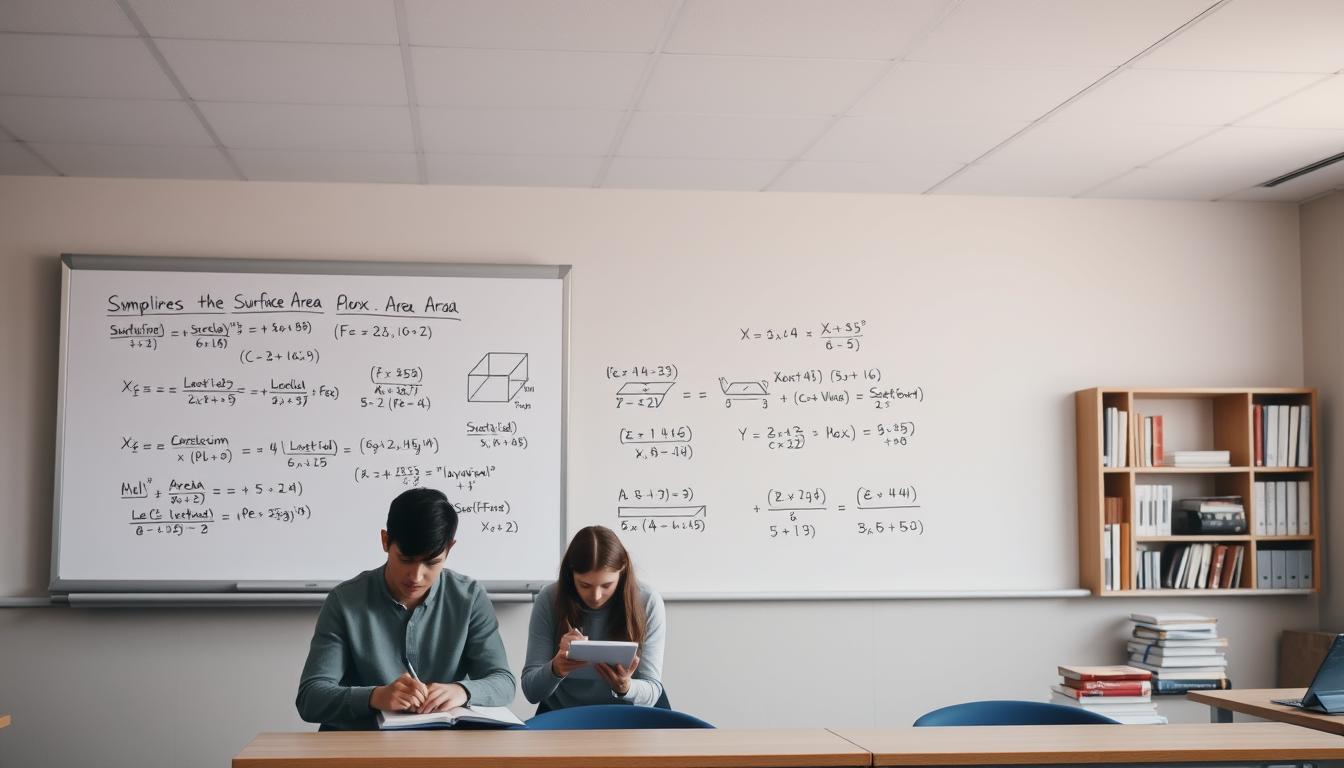Ways to Find the Surface Area of a Box
Finding a box’s surface area requires understanding key geometric calculations and math formulas. Precise techniques are crucial for measuring 3D objects accurately. These skills are vital for students and professionals alike1.
Surface area calculations play a key role in packaging design and architectural planning. The basic method involves measuring each box face and applying specific math principles2.
Surface area depends on a box’s length, width, and height. Professionals use standard formulas to quickly determine total surface coverage1.
These math formulas help solve complex dimensional challenges across various fields. Knowing how to find a box’s surface area is valuable in engineering, design, and mathematics2.
Key Takeaways
- Surface area is measured in square units
- Precise measurements are crucial for accurate calculations
- Different box shapes require specific formulas
- Mathematical consistency ensures reliable results
- Surface area calculations have practical applications in multiple fields
Understanding Box Surface Area Fundamentals
Geometry unveils fascinating insights into rectangular prism volume and box dimensions. A box, or cuboid, is a 3D shape with unique mathematical properties. It captivates both mathematicians and students3.
Geometric shapes reveal complex mathematical relationships. They help us grasp spatial concepts. A typical box has six rectangular faces, each with distinct mathematical traits3.
Key Components of Rectangular Geometry
Rectangle area calculations form the basis for determining box surface area. Let’s explore the essential elements:
- Length: The longest horizontal dimension
- Width: The shorter horizontal dimension
- Height: The vertical measurement
Mathematical Relationships
Rectangular prism volume relies on exact measurements. A box measuring 10m × 6m × 4m has a surface area of 248 square meters4.
“Geometry is the foundation of understanding spatial relationships.” – Mathematical Insight
The box surface area formula follows a specific pattern. It’s SA = 2lw + 2lh + 2wh, where l is length, w is width, and h is height3.
Pro tip: Measure your box’s dimensions carefully for accurate surface area calculations!
Find the Surface Area of a Box: Step-by-Step Method
Calculating a box’s surface area is easier with a step-by-step approach. The surface area formula helps measure the total external area of 3D shapes. It’s useful for both math experts and students.
Start by carefully measuring the box’s dimensions. Imagine the box flattened out to make the calculation simpler.
- Measure the length, width, and height of the box precisely
- Calculate the area of squares and rectangles for each face
- Use the surface area formula: A = 2lw + 2lh + 2wh
Let’s look at a real example. Picture a box with these measurements:
- Length: 7 cm
- Width: 3 cm
- Height: 5 cm
The total surface area would be 142 square centimeters5.
Remember to double-check your work. Aim for two decimal places in your final answer.
Precision is key when working with mathematical calculations!
Advanced Surface Area Calculations
Advanced 3D figures need complex geometric calculations. These go beyond standard rectangular shapes. Complex box shapes require special surface area measurement techniques6.
These intricate calculations help solve real-world spatial challenges. Engineers, designers, and mathematicians use them in their work.
Navigating Complex Geometric Challenges
Cylindrical containers need unique surface area calculations. The formula is surface area = 2b + hc1. Here, b is base area, h is height, and c is circumference.
Geometric calculators can make these complex computations easier. They help streamline the process for various shapes.
Precision in Geometric Measurements
Geometric calculations need careful attention to detail. This is especially true for irregular or non-standard shapes6.
Understanding how dimensions relate to surface area is crucial. It helps professionals model and analyze different spatial configurations accurately.
Each unique shape needs its own approach to determine surface area. This ensures precise measurements for all geometric forms.
FAQ
What are the basic dimensions needed to calculate a box’s surface area?
How do I calculate the surface area of a rectangular box?
What is a net of a solid shape, and why is it helpful?
Can surface area calculations work for boxes with irregular shapes?
Why is understanding surface area important?
How do I handle calculations for an open-top box?
What’s the difference between surface area and volume?
Source Links
- Surface Area of a Rectangular Prism Calculator – https://www.omnicalculator.com/math/surface-area-rectangular-prism
- Surface area of cubes and cuboids – KS3 Maths – BBC Bitesize – https://www.bbc.co.uk/bitesize/articles/zmngkhv
- Surface Area of Prisms, Cubes, and Boxes | sofatutor.com – https://us.sofatutor.com/math/videos/surface-area-of-prisms-cubes-and-boxes
- Difference Between Area and Surface Area – GeeksforGeeks – https://www.geeksforgeeks.org/difference-between-area-and-surface-area/
- Surface Area of a Box Calculator – https://www.math-salamanders.com/surface-area-of-a-box.html
- Surface Area of a Rectangular Prism – Formula, Solved Examples, & FAQs – GeeksforGeeks – https://www.geeksforgeeks.org/surface-area-of-rectangular-prism/
news via inbox
Nulla turp dis cursus. Integer liberos euismod pretium faucibua








